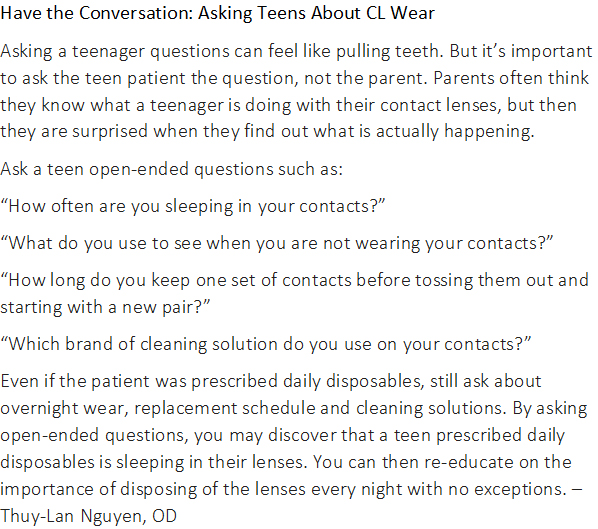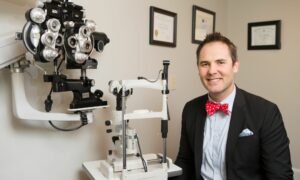By Thuy-Lan Nguyen, OD
Oct. 18, 2017
Contact lenses are a great opportunity for teens to reduce their dependency on glasses, or to cosmetically enhance the color of their eyes. Having more patients in contact lenses also is a win for practices, as contact lens patients have been proven to be more profitable over their lifetime with the practice than glasses-only patients.
I have found that contact lens success is more likely when parents and teens have been educated on safe wearing practices. Taking the time to educate means a greater chance of patients’ eyes remaining healthy and comfortable in their contacts, with less chance of dropping out, or experiencing complications.
Approximately 10-15 percent of my patients are teenage contact lens wearers, ages 13-18. If they have standard spherical refractive errors, I will only prescribe daily disposable or overnight CRT. Therefore 80-90 percent of my young patients wear daily disposable lenses.
The only time I prescribe a reusable soft contact lens to a teenage patient is if they require a high toric prescription or if their parents are interested in myopia control with soft multifocal contact lenses.
 Greater Risk of Complications for Teens
Greater Risk of Complications for Teens
Managing teen contact lens wearers has many challenges, mostly dealing with hygiene and compliance and wearing and replacement schedules. In 2011, the Contact Lens and Youth (CLAY) study group assessed risk factors that contributed to corneal inflammatory events such as infiltrative keratitis in young contact lens wearers.
Risk factors, such as overnight contact lens wear, topping off solutions instead of using fresh solution each day and rinsing lenses with tap water, will increase the risk of corneal inflammatory events in all patients. Behaviors such as regular napping, or accidental overnight wear, and showering while wearing contact lenses, were more common among teenage patients.
Key to Keeping Teens Safe in CLs is Educating Parents
The key to reducing risk of contact lens complications for teens lies in educating the parent. Teens are likely to forget most of what a doctor tells them during the examination. Therefore, it is critical that the parent understands all the instructions, as well as risks and complications, so they can remind and reinforce proper techniques at home.
A major barrier to parents being able to effectively manage their children’s contact lens wear is that many have preconceived notions of contact lenses based on their own history. Many parents will tell me, “My child doesn’t need a daily disposable lens. I’ve been wearing contacts for years. I only replace them when they are bothering me, and I’ve never had a problem.”
To avoid teens over-wearing contacts under the guidance of a parent who over-wears their own lenses, I have a strict policy of prescribing only daily disposables unless the teen needs a high toric prescription, gas permeable lenses, overnight ortho keratology or soft multifocal lenses for myopia control. Those are the only exceptions. I advise parents on the risks of contact lens wear, and I make it clear to them that I will not take any chances when it comes to a young patient’s eye health and vision.
Discussing Benefits of Latest Daily Disposables Diminishes Cost Concerns
Most teens and parents are open to learning about newer, healthier contact lenses, especially since I don’t give them a choice in my policy of almost always prescribing daily disposables.
I educate parents on the benefits of daily disposables such as improved safety, lower risk of complications, such as blinding infections, more stable vision, improved end-of-day comfort, less dryness and more convenience.
Once a teen patient is successful and happy with a particular lens, if a parent is concerned about cost, I will discuss another daily disposable material that may save them money, and still have the benefits of safety, lower risk and more convenience. However, I also let parents know that switching to the less advanced lens may cause their child to experience dryness and discomfort.
If the parent continues to demand a reusable lens, I remind them of the cost of purchasing cleaning solutions. An annual supply of contact lens solutions can cost over $100 per year. When you factor that cost out of the equation, and incorporate manufacturer rebates to help them with out-of-pocket expenses, the majority of parents will agree that a daily disposable modality is the best contact lens for their teenage child.
Five Key Rules for Patients & Parents to Follow
GET PARENTAL CONSENT. It is the law in all 50 states to get parental consent before performing any examination on a patient who is a minor, even if they are an established, long-term patient. Get parental consent even if you know the parents. This is a hard rule of mine. I prefer if the parent is in the exam room with me. If a young patient is accompanied by an adult, but not a legal guardian, such as older sibling, grandparent or friend, or if they are of driving age and they drove themselves, get consent over the phone before performing an examination, ideally as early as when the appointment is booked.
If the adult claims to be responsible for the patient, ask them specifically if they are the “legal guardian.” Otherwise, use the office landline to call the parent, documenting their name and phone number. Explain the basics of a contact lens examination, need for follow-up examinations, examination fees and out-of-pocket expenses before performing the exam. If the parent does not answer the call right away, leave a simple message asking them to call the office back right away without divulging any HIPAA-protected information about the patient.
If a teen patient walks in without an appointment needing service, inform them that their examination may be delayed, or it may need to be rescheduled if their parent does not call the office back in a timely manner. I will tell parents over the phone, “I’m sure So And So is a very responsible 17-year-old, but I just wanted to make sure you knew they were here, and what we are going to do. The comprehensive eye examination is $XX, and the contact lens examination is an additional $XX. Are you OK with that?”Once I have that conversation with parents, they are typically appreciative.
If you don’t have that conversation with a parent in advance, there is a strong possibility that you will get an angry phone call as soon as the teenager gets home.
TEEN STILL NEEDS GLASSES. Contact lenses do not replace glasses. It’s not either contacts or glasses. It is both. I tell my teen contact lenses wearers, “You don’t get to throw your glasses away. You will still need glasses. You will still wear glasses. Contact lenses only offer an alternative way to see clearly when having glasses on your face is not convenient.” This is another non-negotiable rule of mine. I will not finalize a contact lens prescription unless I know for sure that the patient has back-up glasses.
CL TRAINING IS A MUST. Teens who are new to contact lenses must go through the proper contact lens training before leaving the office with contacts. Even if mom, dad or siblings are experienced contact lens wearers, the teenage patient must demonstrate proper insertion and removal techniques before going home with lenses for the first time.
Teens who are new to contact lenses may spend more time with a technician than they do with the doctor. Often, it takes longer to teach a teen the proper insertion and removal techniques than it does to perform the evaluation of their contact lenses.
Therefore, support staff must also be knowledgeable on details, such as wearing and replacement schedule, which specific solutions to prescribe, or when to use no solutions at all, and when the doctor needs to see the patient back for additional examinations.
Parents should observe the insertion and removal training, but sometimes, the parent will make their teenage child feel more nervous. Technicians should recognize if a parent is being counterproductive, and politely ask the parent to wait in another room. Once training is successful, then techs should repeat the education with both parent and teen again.
NO SOLUTION STARTER KITS. Do not give a solution starter kit to patients wearing daily disposable lenses. This sends a signal that their daily disposable lenses can be cleaned. If they drop the lens before it gets onto their eye, they can dip it into the sterile solution from the manufacturer’s packaging. If they drop their lens more than once, they should throw it out and open a new lens.
TEACH REMOVAL PRIOR TO BED. Teach patients and parents the importance of removing contact lenses an hour or two before going to bed. Don’t let teens wait until the last second before going to sleep to take contact lenses out. Parents should see their teenager wearing glasses before the end of the night to ensure they won’t sleep in their lenses, and to allow their eyes a break from contacts after a long day of wearing.
 Thuy-Lan Nguyen, OD, practices in South Florida, teaches at Nova Southeastern University College of Optometry, and works part-time as an associate at We Are Eyes in Boca Raton, Fla. To contact her: TLNGUYEN@nova.edu
Thuy-Lan Nguyen, OD, practices in South Florida, teaches at Nova Southeastern University College of Optometry, and works part-time as an associate at We Are Eyes in Boca Raton, Fla. To contact her: TLNGUYEN@nova.edu


























